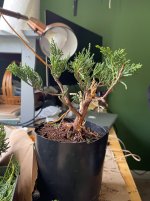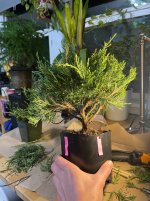Yes. As long as it's producing juvenile foliage it's experiencing some kind of stress that it's responding to. That stress can be in the past, but if the response is still there it means that the plant hasn't gotten back to a homeostatic equilibrium. That's a fancy way of saying "It's not back to normal yet". If you ever want to impress a biologist, use that phrase whenever something is out of the ordinary.
In theory, you can repot whenever. But if you want to be efficient about your time, keep in mind that a weak repot can set your development back by a couple years. In that time you just water the plant, keep it recovering, and in all that time you as a practitioner learn very little about it. A strong plant being repotted should bounce back within the same year. Sometimes people are lucky, but I prefer beginners to go hard on the bending and soft on the repotting. A broken branch can heal, a dead plant can not. Junipers especially can produce a whole bunch of roots from their trunks and leaving them in organic soils should not be an issue if you monitor the watering closely. As a matter of fact, we see from people like Eric Schrader (bonsaify on youtube) that 40-60% organics like coco coir, can yield huge amounts of growth. My own junipers did better in low-pH-black-peat than they ever did in bonsai soil.
I'm trying to advocate a more precise description of the roots' status. "Pot bound" should mean the plant is pushing itself out of the pot because there is absolutely zero other space for the roots and it should inhibit top growth. If that's not the case, it's just a healthy root system. A healthy root system doesn't require a repot. Some circling roots are not an issue. Water a little less for a week in the summer and they prune themselves.






